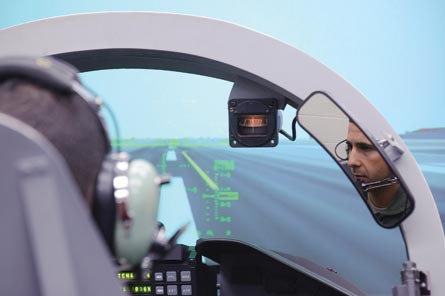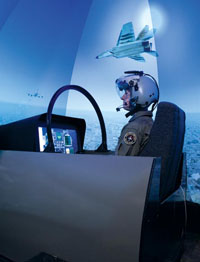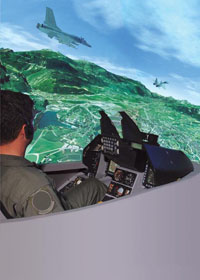It will take more than an aircraft to replace the Northrop T-38C Talon as the US Air Force's advanced trainer for fighter and bomber pilots.
Ground-based training systems, such as full-flight simulators and procedures trainers, have made inroads in all areas of military pilot training. But simulation technology is poised to assume a new level of importance as the USAF considers a replacement for its 50-year-old fleet of advanced trainers for all fighter and bomber pilots.
Part of this projected shift is driven by the US military's desire to reduce the cost of training pilots. In fiscal year 2009 alone, according to a recent analysis by the Frost & Sullivan consultancy, the Department of Defense spent $22.2 billion on training devices, with a proportional demand for a return on investment.
"There's an expectation in [the office of the secretary of defence] that, if a new training system is being bought, I would expect training to move from the aircraft into the ground-based training systems to get some cost savings just from the technology that's coming forward," says Mark McGraw, Boeing's vice-president of training systems and services.
|
|---|
|
|---|
Another major factor is the challenge posed by the growing complexity of combat aircraft. The USAF is shifting from fourth-generation fighters, such as the Boeing F-15 and Lockheed Martin F-16, to fifth-generation "flying combat systems" such as the Lockheed F-22 and F-35A.
The F-35A, in particular, adds new sensors, including a distributed aperture system, and new missions, such as armed reconnaissance and the suppression or destruction of enemy air defences. Managing these new sensors and role must be squeezed into the USAF's IFF curriculum - the last stage of formal training before pilots are inducted into operational units.
In addition to new sensors and missions, fifth-generation fighters uniquely share a common characteristic that will challenge how to prepare pilots for operational units. The F-22 and F-35 are single-seat fighters, with no two-seat versions for key training missions.
The USAF is aware of the problem. A market survey issued earlier this year lists five training requirements that "lend themselves" to a two-seat trainer. High-g manoeuvres and air refuelling are conducted in two-seat aircraft for safety reasons. Three other training missions - night vision imaging systems, dogfighting and managing datalinks - are conducted in two-seat aircraft for efficiency reasons, according to the USAF market survey.
As the T-38C is replaced, the USAF is entertaining new ideas, suggesting the air refuelling mission could be downloaded from a flying sortie to a full-flight simulator.
ADVANCING TECHNOLOGY
|
|---|
Lenny Genna, president of the Link Simulation and Training division of L-3 Communications, notes that the T-38 replacement is not due to arrive for at least six years. For a technology driven by Moore's Law, which predicts a doubling of processing power every 18 months, that allows the industry about four major cycles of computing upgrades.
"A lot changes in this industry in six years," Genna says. "The amount of processing power and the amount of content we will be able to provide in a visual system will be much easier to obtain."
The challenge for the USAF will be maintaining support for the T-38C replacement programme as pressure rises on spending budgets. Overall defence spending is expected to be steady, but modernisation accounts are forecasted to decline as personnel and operations costs increase.
For T-X to remain on track, the USAF's leaders must commit to buying trainers even as budgets to acquire combat aircraft get squeezed over the next several years.
An analysis of alternatives for the T-X advanced trainer programme is under way, having been delayed by about three months. But the USAF still plans to field a "family of systems", to include an aircraft and full flight simulator, by FY2017. The USAF wants all aircraft and simulators delivered seven years later, although follow-on orders by the US Navy could extend production for aircraft and simulators by several years. The scope of the programme also could expand to include a light attack version of the basic trainer.
Expansion is a possibility, but the USAF is focusing requirements for the T-X competition on the trainer mission alone.
Each of the major airframe suppliers has hosted the USAF team of analysts working on the alternatives study in August and September. More recently, the team paid visits to simulator vendors, including L-3 Link, Genna says.
The bidders expect to see a draft version of the alternatives study in the first quarter of 2011. Perhaps more importantly, the DoD's FY2012 budget request will be released in early February. Industry officials do not expect to see major changes in the funding line for the T-X programme, as the alternatives study is being completed too late to inform DoD's FY2012 budgeting process. The USAF is not expected to commit major funds for T-X until at least the FY2013 budget.
Until then, the USAF has only left a placeholder for the T-X competition as a new-start programme in this year's budget, with about $30 million budgeted up to FY2015. That is enough to complete studies and organise a programme office, but not nearly the investment level required to support a development programme in time for a FY2017 service entry.
As the USAF continues to plan for the T-X programme's acquisition strategy and funding profile, the size of the opportunity has attracted a wide range of potential bidders for both platforms and simulators. The contract is expected to lead to production orders for between 350 and 500 aircraft, the biggest prize by far in the global military trainer industry.
Alenia Aermacchi has proposed the M-346 rebranded as the T-100, BAE Systems has touted the Hawk T2/128 and Lockheed Martin/Korea Aerospace Industries has offered the T-50. Meanwhile, Boeing and Northrop Grumman are considering options, with the former considering an all-new purpose-built airframe for T-X. Northrop has the option of proposing a service-life extension for the T-38.
Aircraft platforms have made the biggest headlines in the competition, but the simulator technology is at least equally important.
CAE believes the world market for military-operated full-flight simulators up to 2015 is about 60 a year. By that standard, winning the T-X contract is not just a major aircraft order.
The USAF has said little about its needs for simulators as part of the T-38 replacement. But a market survey by the Air Education Training Command this year asked industry to provide pricing based on an order for 35 or 50 simulators. The top end of the USAF estimate represents nearly a full year of output for the global military simulator market.
Simulators are often thought of as complements to flight training, but T-X may elevate the status of ground-based training devices for future USAF pilots. The change is not driven because the USAF expects new technology breakthroughs to revolutionise how simulators operate.
Source: Flight International



















